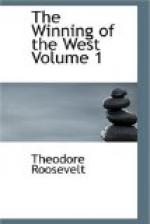In the following year numerous parties of surveyors visited the land. One of these was headed by John Floyd, who was among the ablest of the Kentucky pioneers, and afterwards played a prominent part in the young commonwealth, until his death at the hands of the savages. Floyd was at the time assistant surveyor of Fincastle County; and his party went out for the purpose of making surveys “by virtue of the Governor’s warrant for officers and soldiers on the Ohio and its waters."[38]
They started on April 9, 1774,—eight men in all,—from their homes in Fincastle County.[39] They went down the Kanawha in a canoe, shooting bear and deer, and catching great pike and catfish. The first survey they made was one of two thousand acres for “Colo. Washington”; and they made another for Patrick Henry. On the way they encountered other parties of surveyors, and learned that an Indian war was threatened; for a party of thirteen would-be settlers on the upper Ohio had been attacked, but had repelled their assailants, and in consequence the Shawnees had declared for war, and threatened thereafter to kill the Virginians and rob the Pennsylvanians wherever they found them.[40] The reason for this discrimination in favor of the citizens of the Quaker State was that the Virginians with whom the Indians came chiefly in contact were settlers, whereas the Pennsylvanians were traders. The marked difference in the way the savages looked at the two classes received additional emphasis in Lord Dunmore’s war.
At the mouth of the Kanawha[41] the adventurers found twenty or thirty men gathered together; some had come to settle, but most wished to explore or survey the lands. All were in high spirits, and resolute to go to Kentucky, in spite of Indian hostilities. Some of them joined Floyd, and raised his party to eighteen men, who started down the Ohio in four canoes.[42] They found “a battoe loaded with corn,” apparently abandoned, and took about three bushels with them. Other parties joined them from time to time, as they paddled and drifted down stream; and one or two of their own number, alarmed by further news of Indian hostilities, went back. Once they met a party of Delawares, by whom they were not molested; and again, two or three of their number encountered a couple of hostile savages; and though no one was hurt, the party were kept on the watch all the time. They marvelled much at the great trees—one sycamore was thirty-seven feet in circumference,—and on a Sunday, which they kept as a day of rest, they examined with interest the forest-covered embankments of a fort at the mouth of the Scioto, a memorial of the mound-builders who had vanished centuries before.




